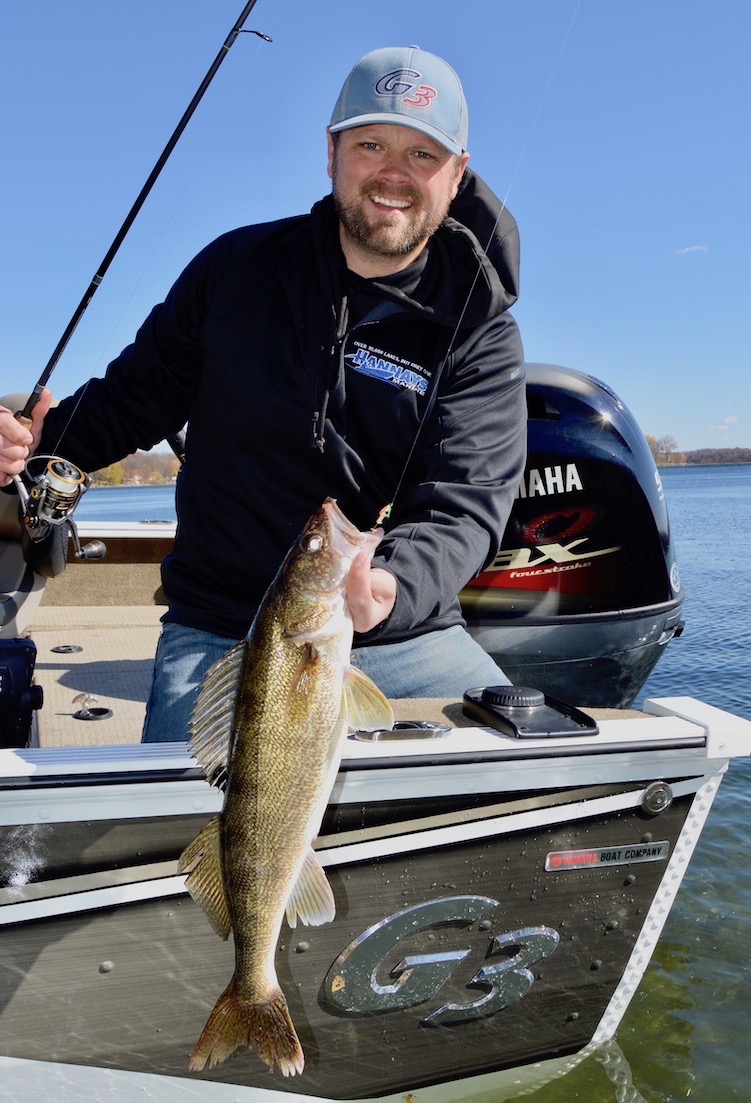News & Stories
Trophy Time!
Posted by director on October 4, 2021

Trophy time!
By Mike Frisch
There may not be a better month than October for those of us who love the outdoors. Hunting seasons are in full swing and some of the season’s best fishing action occurs now. Fish of all species are often cooperative, plus some of the year’s biggest fish find the bottom of landing nets now too. Here are ways anglers can increase the odds of a trophy-fish coming in their boat this month!
The key to finding big fish, regardless the season or the species, is going where they live. That sounds simple, but some anglers get frustrated because they rarely catch big fish when maybe the waters they fish just simply don’t have many! For that reason, spending most of your fishing time on lakes that are known to produce big fish with some regularity is one way to tip the trophy odds in an angler’s favor.
Once a “big fish” destination is chosen, targeting it during the right time frame is another way to increase the odds. The bite for many, if not most, fish species is usually best in spring and fall, with the bigger female fish being more predictable biters during fall as the rigors of the spring spawn are not a concern now. Very late fall – November - can, however, mean downright cold water and a tougher bite. That’s another reason October is prime time!
Being on the right lake during prime time will certainly increase your odds for angling successes, particularly when targeting trophy-sized fish. Another key to success is using the right baits, particularly the right-sized baits. Big fish are used to eating bigger prey, meaning larger baits often rule during fall.
Slip-sinker live bait rigs, aka “Lindy rigs,” tipped with a big minnows like redtail chubs, creek chubs, or sucker minnows are often used by walleye anglers in the know when chasing big fish. “Big” used to mean minnows in the 4- to 6-inch size range. Recently , however, several of the biggest walleyes caught in Midwestern fall walleye tournaments have come on minnows 7 inches in size and even bigger!
Smallmouth bass are my favorite fall fish to target. Tubes in the 2 ½-inch size range and finesse plastics on drop-shot rigs catch numbers of bass, but the bigger specimens are often caught on bigger baits. My best “big fish” tube, for example, is a 3 ½” KVD Pro Model Tube.
Largemouth bass fishing during fall often means locating fish relating to what’s left of green, living weeds along deep weedlines. These fish often eat crankbaits and using bigger-sized baits that reach the deeper depths the bass are found in now is key. These bigger baits also appeal to bigger bass now too.
Big baits fished at the right time in the right waters is often a winning formula for getting a big fish to bite during fall. Then, being patient and using good fish fighting and landing skills are required to close the deal. Taking your time to not rush a big fish and then being ready for the fish’s inevitable “last run” at the boat are essential. A final key is to have a big, sturdy landing net designed for large fish. I’ve been using the new Fortis nets recently and found them to be sturdy and strong and feature engraved rulers on the handles so I can quickly measure and release a trophy fish.
If landing the fish of a lifetime is your goal, October is a great time to be on the water. The fish are biting and, using the ideas just shared maybe, just maybe this might be your year!
As always, good luck on the water and remember to include a youngster in your next outdoors adventure.
Mike Frisch hosts the popular Fishing the Midwest TV series. Visit fishingthemidwest.com for more "fishy" stuff.
PHOTO – Mike Frisch with a pair of big largemouth bass
A Fall Smorgasbord On the Weedline
Posted by director on September 20, 2021

A FALL SMORGASBORD ON THE WEEDLINE
by Bob Jensen
From as soon as weedbeds are established in early summer and well into the autumn months, the deep weedline is a very good place to look for hungry predator fish. They’ll be there looking for something to eat, and if they see your bait, the chances are good that they’ll eat it. Following are some ideas for catching fish on the weedline right now and for the next few weeks.
Across much of the Midwest, the vegetation that forms the weedbeds that the deep weedline is part of consist mostly of cabbage weed. There will be some places where coontail is present or even dominant, and some other types of vegetation may be mixed in also, but cabbage weeds are usually most prominent. Depending on water clarity, the deep weedline can be in seven feet of water in lakes that have less clarity to eighteen or even twenty feet of water in lakes that have more clarity. Due to clearer water across much of the Midwest, the deep weedline can be found in deeper water in more places than in the past.
When you find a spot where the weedline juts out a bit and forms a point, you’ve found a place that will often hold a concentration of fish. They could be walleyes or largemouth bass, but it’s not unusual to find a musky or northern pike roaming around also. You’ll find fish tightly grouped on and in the points and the pockets, but you’ll also find individual fish scattered along the edges. A casting presentation will usually be best. Casting allows an angler to keep the bait along the edge where the fish are. Keep moving and casting until you catch a fish, then slow down and work the area thoroughly.
Lots of techniques will take fish along the weedline in the fall, but it works really well to start by throwing a crankbait. There are usually at least two anglers in the boat when we go fishing, and often there will be three of us. Everyone should start with a different shape and color of crankbait. Someone should be casting a longer, thinner crankbait, something like a Lucky Shad. This shape is most appealing to walleyes, but bass or pike will also readily hit it.
Another angler should have a shorter, fatter crankbait on the end of their line. A Pro Model XD crankbait fits this description. It’s designed for largemouth bass, but it has been the reason a lot of walleyes have been introduced to a landing net.
The usual idea when it comes to lure color is to go with natural appearing baits in clear water and brighter baits in stained water, but that’s only a starting point. There are times when the fish want a particular color, so keep trying different colors until the fish reveal their color preference for that day or that time-of-day.
If you’ve taken a few fish off a particular spot on the crankbait but they slow down or quit, before you move on, work a jig/plastic or jig/minnow through the area that produced the fish. That will usually get a couple more to bite.
If it’s a calm late afternoon or early evening when you’re on the water, keep an eye out for fish dimpling the surface near the weedline. If you see some activity, move very quietly toward the dimpling and throw a sixteenth ounce jig tipped with plastic or a minnow. Swim it slowly through the area being dimpled and you’ll probably catch some crappies. The dimples are created by crappies sucking bugs off the surface. Since the crappies are feeding on the surface, you’ll want to swim your bait just a couple of feet down. It might work even better to fish the jig below a slip-bobber. I’ve done this several times in the past with good success.
The weedline can provide lots of fall action. Make sure you’re fishing healthy green weeds and keep moving until you find the fish. Catch a few, then when the action slows move farther along the weedline. You’ll get bit, you’ll have a good time, and that’s why most of go fishing.
Fall Walleyes In Shallow Lakes
Posted by admin on September 2, 2021

Fall walleyes right now!
By Mike Frisch
Fall is a great time to be on the water fishing as the pleasure boaters, water skiers, and jet skiers are gone and, of course, the fish often go “on the chew” in preparation for the coming winter. Walleyes that have been largely ignored the past couple months are among those hungry fish. While big, deep lakes are often thought of as “classic” walleye waters, many small, shallow lakes have good walleye populations that usually bite now too.
My search for fall walleyes in shallow, weedy lakes usually starts along the lake’s first drop-off, that area where the shoreline flat starts to drop to deeper depths. This drop off typically occurs in depths from 6 to 12 feet deep.
Searching along any points and turns along the drop-off is often a good starting point. Also, spots where bottom composition changes, maybe rocks to sand, can be fish magnets too. Turns, points, and bottom transitions are often good spots during the spring bite on these lakes and produce again during fall.
As fall progresses, my focus turns to finding green, living weeds which may grow up on the flat and extend down the drop off. In fact, particularly as fall progresses, an area of green weeds will often be the “spot on the spot” for finding fish.
The tried and true jig and minnow combination slowly trolled or drifted along a lake’s first drop-off is one way to find the fish-holding areas and/or living weeds. Simply drifting and slowly fishing a light jig and minnow combination on a long line is a great way to eliminate unproductive water and find walleye schools. Also, today’s modern electronics featuring Side Imaging are also great tools for finding weeds, bottom changes, and fish!
Once fish or likely areas are found, the catch can often be maximized by anchoring using a trolling motor’s “Spot-Lock” feature and pitching jigs and minnows to the fish. Pitching is a great way to catch a bunch of fish from a small area.
Small 1/16 and 1/8 ounce size jigs get the nod when drifting or pitching. Bright colored jigs are often preferred, particularly when the water is somewhat “off colored” which is typical in many shallow lakes. Various minnows will produce, but a scoop of lively fatheads is often all that is needed during fall. On calm days, or any time the fish are very shallow, 1/16 ounce size jigs gets the nod, though I prefer 1/8 ounce jigs if the wind kicks up or when drifting or slow trolling to find fish.
Small jigs and minnows fish well on spinning gear and light line. My rod choice is a Lew’s Speed Stick walleye jigging rod paired with a Custom Pro spinning reel loaded with 8 pound fluorocarbon line. The jigging rod is light and super sensitive and the reel is buttery smooth and has a reliable drag, which is important when a hard fighting shallow fall walleye is hooked on light line!
If you are looking for some hard fighting fall walleyes this year, consider heading to a small, shallow lake right now. Rig up a spinning rod with a jig, grab a scoop of fatheads, and head to the spots just described and you just might land on walleye gold!
Be safe on the water and, as always, remember to include a youngster in your next outdoors adventure!
Photo - An angler with a fall walleye caught on a jig!
Mike Frisch hosts the popular Fishing the Midwest TV series. Visit www.fishingthemidwest.com or follow Fishing the Midwest on Facebook for more “fishy” stuff.
